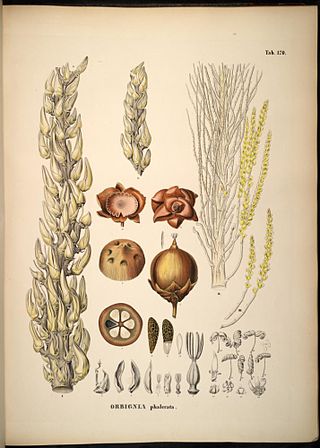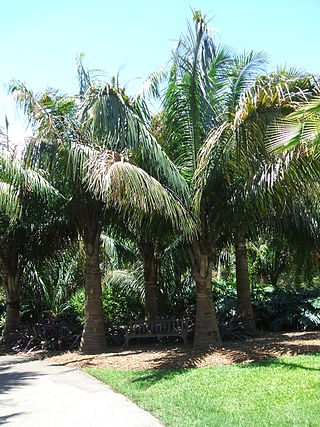
Plantations are farms specializing in cash crops, usually mainly planting a single crop, with perhaps ancillary areas for vegetables for eating and so on. Plantations, centered on a plantation house, grow crops including cotton, cannabis, coffee, tea, cocoa, sugar cane, opium, sisal, oil seeds, oil palms, fruits, rubber trees and forest trees. Protectionist policies and natural comparative advantage have sometimes contributed to determining where plantations are located.

Elaeis is a genus of palms containing two species, called oil palms. They are used in commercial agriculture in the production of palm oil. The African oil palm E. guineensis is the principal source of palm oil. It is native to west and southwest Africa, occurring between Angola and Gambia. The American oil palm E. oleifera is native to tropical Central and South America, and is used locally for oil production.

Heart of palm is a vegetable harvested from the inner core and growing bud of certain palm trees, most notably the coconut, juçara, açaí palm, palmetto, and peach palm. Harvesting of many uncultivated or wild single-stemmed palms results in palm tree death. However, other palm species are clonal or multi-stemmed plants, and moderate harvesting will not kill the entire clonal palm. Heart of palm may be eaten on its own, and often it is eaten in a salad.
Lauric acid, systematically dodecanoic acid, is a saturated fatty acid with a 12-carbon atom chain, thus having many properties of medium-chain fatty acids. It is a bright white, powdery solid with a faint odor of bay oil or soap. The salts and esters of lauric acid are known as laurates.

Byrsonima crassifolia is a species of flowering plant in the family Malpighiaceae, native to tropical America. Common names used in English include nance, maricao cimun, craboo, and golden spoon. In Jamaica it is called hogberry.

Sayulita is a small town in Mexico along the Pacific Ocean at the south end of the state of Nayarit and north of Banderas Bay. It has a population of approximately 2,300 inhabitants.

Attalea maripa, commonly called maripa palm is a palm native to tropical South America and Trinidad and Tobago. It grows up 35 m (115 ft) tall and can have leaves or fronds 10–12 m (33–39 ft) long. This plant has a yellow edible fruit which is oblong ovoid and cream. An edible oil can be extracted from the pulp of the fruit and from the kernel of the seed.

Astrocaryum is a genus of about 36 to 40 species of palms native to Central and South America and Trinidad.

Attalea speciosa, the babassu, babassu palm, babaçu, or cusi, is a palm native to the Amazon Rainforest region in South America. The babassu palm is the predominant species in the Maranhão Babaçu forests of Maranhão and Piauí states.
The flora of Belize is highly diverse by regional standards, given the country's small geographical extent. Situated on the Caribbean coast of northern Central America the flora and vegetation have been intimately intertwined with Belize's history. The nation itself grew out of British timber extraction activities from the 17th century onwards, at first for logwood and later for mahogany, fondly called "red gold" because of its high cost and was much sought after by European aristocracy. Central America generally is thought to have gained much of it characteristic flora during the "Great American interchange" during which time South American elements migrated north after the geological closure of the isthmus of Panama. Few Amazonian elements penetrate as far north as Belize and in species composition the forests of Belize are most similar to the forests of the Petén (Guatemala) and the Yucatán (Mexico).
Cohune oil is pressed from the seeds of the cohune palm, which is native to Central and South America.

Attalea crassispatha is a palm which is endemic to southwest Haiti. The most geographically isolated member of the genus, it is considered a critically endangered species and has been called one of the rarest palms in the Americas.

Attalea is a large genus of palms native to Mexico, the Caribbean, Central and South America. This pinnately-leaved, non-spiny genus includes both small palms lacking an aboveground stem and large trees. The genus has a complicated taxonomic history, and has often been split into four or five genera based on differences in the male flowers. Since the genera can only be distinguished on the basis of their male flowers, the existence of intermediate flower types and the existence of hybrids between different genera has been used as an argument for keeping them all in the same genus. This has been supported by recent molecular phylogenies.

Aphandra is a monotypic genus of flowering plants in the palm family native to the Amazon rainforest vegetation in South America. Its only species is Aphandra natalia, sometimes called mastodon palm or fiber palm, and is used by indigenous peoples in the construction of brooms and other products. This plant is commercially exploited for its edible fruits, and for its leaf sheath and petiole fibers. This fiber is almost equal to the fiber extracted from Attalea funifera and Leopoldinia piassaba, which is called piassava.

The forests in the U.S. state of Texas have been an important resource since its earliest days and have played a major role in the state's history. The vast woodlands of the region, home to many varieties of wildlife before Europeans first showed up, provided economic opportunities for early settlers. They continue to play an important role economically and environmentally in the state.

Attalea phalerata is a species of palm tree known by the English common name urucuri palm, the Portuguese common name urucurizeiro, and the Spanish common name shapaja. Other common names include motacu and bacuri. It is native to Brazil, Bolivia, Paraguay, and Peru, where it grows along southern and western Amazonia. It is the most common palm tree on the Pantanal.

Elaeis guineensis is a species of palm commonly just called oil palm but also sometimes African oil palm or macaw-fat. It is the principal source of palm oil. It is native to west and southwest Africa, specifically the area between Angola and The Gambia; the species name, guineensis, refers to the name for the area called Guinea, and not the modern country Guinea now bearing that name. The species is also now naturalised in Madagascar, Sri Lanka, Malaysia, Indonesia, Central America, Cambodia, the West Indies, and several islands in the Indian and Pacific Oceans. The closely related American oil palm E. oleifera and a more distantly related palm, Attalea maripa, are also used to produce palm oil.

The Belizean pine forests is an ecoregion that represents an example of lowland and premontane pine forests in the Neotropical realm, where the dominant tree species is Caribbean pine. The vegetation here is generally adapted to the xeric, acidic and nutrient-poor conditions along the Belizean near coastal zone of the Caribbean versant.

Attalea dubia, also known as the Indaiá plant, babassu palm, or bacuaçu palm is a flowering plant in the family Arecaceae, native to the Southern and Southeast Regions of Brazil.
















